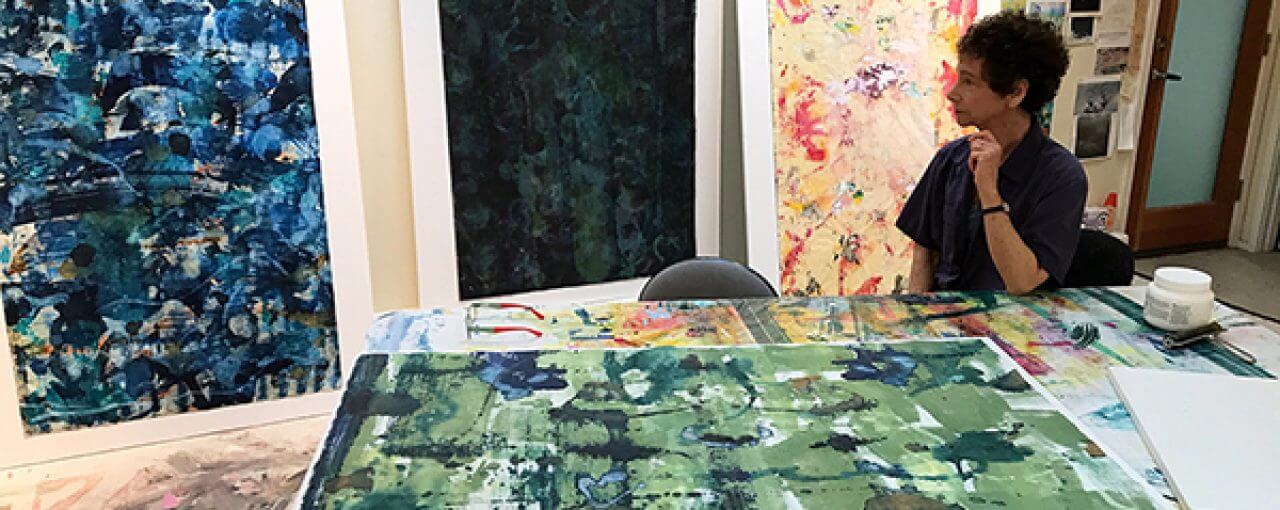“Ink is unparalleled in its fluidity,
staining intensity, and transparency.”
Interview by Jennifer Nelson, WTP Feature Writer
Naomi Schlinke is a Texas-based artist, whose work has been exhibited at the Robert McClain Gallery in Houston, The Dallas Contemporary, Texas State University in San Marcos, D. M. Allison Gallery in Houston, Women and Their Work, D Berman Gallery, and the Dougherty Art Center, all in Austin. Before moving to Austin from San Francisco in 1994, she exhibited with the Braunstein-Quay Gallery in San Francisco. In the 1970s and early ’80s, Schlinke danced with the Margaret Jenkins Dance Company and the Joe Goode Performance Group, both based in San Francisco. Much of her approach to painting is founded on her experiences as a dancer. She earned a BA and MA in Dance from the University of Wisconsin-Madison. She grew up in Dallas, Texas.
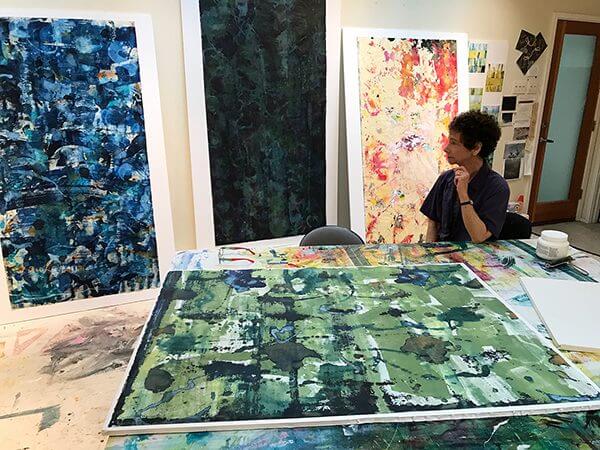
Nelson: Your ink paintings resemble a palimpsest—a manuscript page from which text has been washed off to make room for later writings—in that layers reveal in varying degrees what’s beneath. How do you achieve this effect?
Schlinke: That is a beautiful comparison. The lure of the palimpsest is the opportunity it gives one to peer through a fleeting record of action. The transparency of the ink allows much of the history of execution to be readily visible. As a result, layers switch back and forth in time, creating several possible readings. Simple motifs and events transform throughout repeated layers, becoming a part of later forms. The choice to make this available to the eye is significant. It gives the work a distinctly existential reading. So although my work mirrors patterns from nature—atmospheric, kinesthetic, tactile, and tectonic—it also registers the passing of my own lived moments.
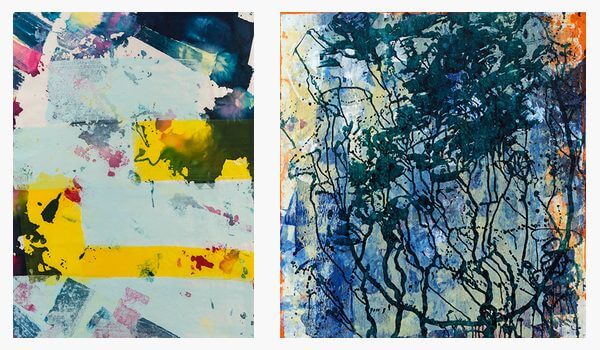
R: Naomi Schlinke, String Theory, 2018. 40” x 37.25”
Nelson: What are the advantages and challenges of ink?
Schlinke: Ink is unparalleled in its fluidity, staining intensity, and transparency. On unsized mulberry paper, it sinks and spreads rapidly through the fibrous surface. This requires a willingness to accept the path of the stain as integral to the image. Transparency should be anticipated and turned into an asset. Otherwise, the surface becomes cluttered rather than replete. The watery fluidity requires that the work be created on a tabletop (unless one is interested in painting waterfalls!). Horizontal application can create both opportunities and difficulties. It does allow one to work freely from all sides. However, large-scale work demands a long reach to the center of the work from these edges.
The advantages and challenges of any medium lie in their relationship to intention and appetite. An asset in one situation might be a liability in another. Comparing water and oil as vehicles of suspension gives clue to their best-suited sensuous task. As an aside, the term “ink” may include technically different materials. For the most part, I have used Dr. Ph. Martin Bombay inks. It is a water-based pigmented ink that includes some acrylic binder. Really, there is a continuum from this kind of ink, through fluid acrylics, to full-bodied acrylic paint.
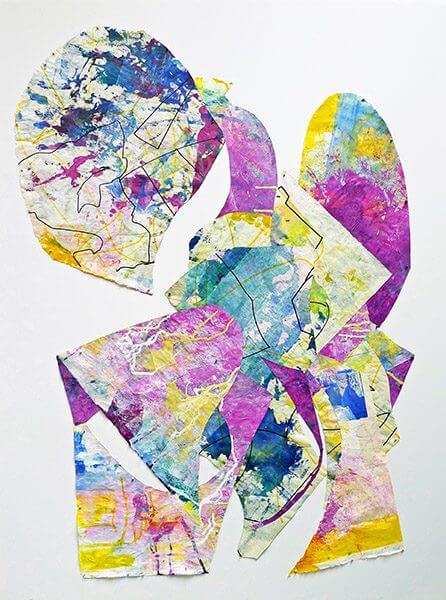
Nelson: Your Painterly Collage series is made from fragments of your own paintings. Can you talk about this as a series? Is it a natural progression to your work or more of, perhaps, a diversion?
Schlinke: Although the painterly collage stands on a foundation of painting, it has its own distinct life. The collage work offers a figure-ground relationship that seems out of place in the fluid all-over structure of the paintings. Sometimes I demolish finished paintings, but increasingly, I paint “episodes” that are deliberately constructed with the future collage work in mind. While the episodes are freely moving, the collages allow for a more clean-edged tension. Tearing and cutting the virtual spaces of the painting produces an exciting visual paradox when the pieces are stacked or overlapped within the collage. These relatively static forms are more body-like than those found in the paintings.
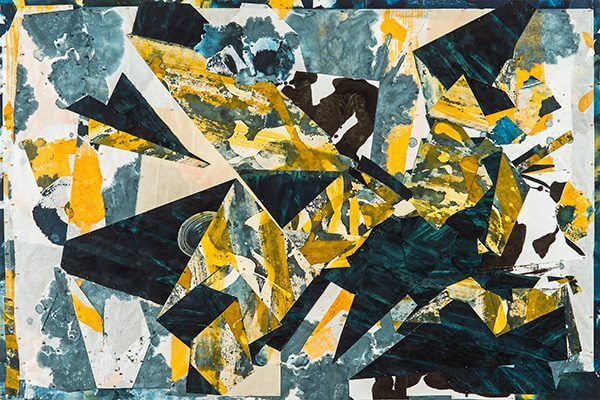
Nelson: Earlier in your career, you painted on Claybord, a hardboard coated with kaolin clay. How did you come to painting on Claybord and what are its benefits?
Schlinke: The surface is as much a player as the ink medium. As with dance, you select the shoe that benefits the kind of moves you want to make. Both unsized mulberry paper and Claybord are intensely absorbent surfaces. The former allows the ink to spread deeply into the paper fibers, creating irregular organic edges, while the Claybord excels at crisper edges. One is soft, textured and tearable, the other is hard, smooth, and flat. The absence of sizing in the paper allows one to paint on one side of the paper to the benefit of the other; viable imagery may appear on both sides. The Claybord can withstand numerous revisions, even heavy sanding.
What interests me most is to find the shortest distance between the nature of the materials and the image produced. I look for an image that appears to be “naturally occurring” like rain or snow—something that is perpetually in transition. I make use of the uncanny resemblances that occur, allowing them to resonate, suggesting a narrative dimension.
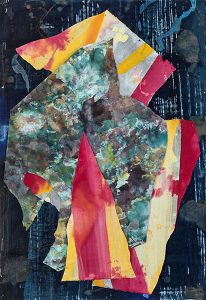
Nelson: What led you to become a visual artist after being a dancer for many years?
Schlinke: The transition from dance to painting as my primary professional focus began in my mid-thirties, a pivotal age for all athletes. The dance life is very public, even in the making of work. It is physically driven and more constrained by contingencies of production. During my years in dance, I often repaired myself within the relative autonomy and privacy of painting. I found myself drawn to a future of greater solitude and flexibility that the painting life offered—to say nothing of the rewards of creating work that one can live with day-by-day. Nevertheless, the forces at work on the dancing body still adhere in my painting.
Nelson: How have your experiences as a dancer impacted your approach to painting?
Schlinke: Much of my approach to painting is founded on the experiences that I absorbed as a dancer. The ideas of Merce Cunningham, John Cage, and other Black Mountain graduates figured prominently in the artistic milieu of San Francisco in the 1970s. Working with Bay Area luminaries like Margaret Jenkins, Joe Goode, and A.A. Leath was critical to my development.
The kinesthetic experiences of gravity—like falling, tilting, floating, and spinning—are integral to my work. My instructions to myself as I paint are often in terms that a dancer would understand, like “move quickly from point a to b.” Shutting my eyes and allowing myself to embody a painterly action produces results that often surpass pure visual manipulation. I try to build a sense of wholeness and beauty that includes the natural flaws and perfections of lived experience.
Nelson: What artists have inspired you in your artwork that often evokes nature?
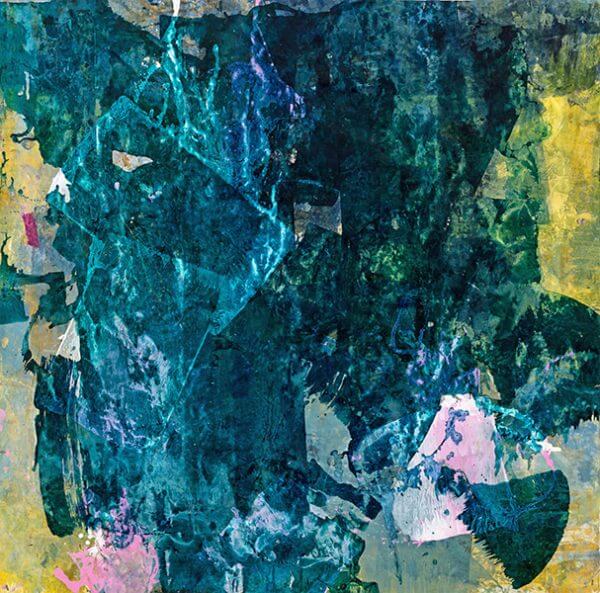
Schlinke: From an older generation, I’ve admired Bill Jensen, Brice Marden, Pat Steir, and Cy Twombly among others. But I have a folder on my computer named “fellow travelers” where I collect images of other artists’ work that seems to be dealing with similar issues as my own. There are now over five hundred images that include relative contemporaries, like Erin Lawlor, Marcelyn McNeil, Amy Sillman, and Fran O’Neill among many.
My idea of the evocation of nature lies largely in the unfolding of organic events like rushing water, wind, or decay, rather than say, leaf forms—though those are there also. Looking closely at the patterns of the ink, one can see universal schemes like branching, spirals, meanders, and waves. The natural cycles of chaos and order work synergistically within my paintings. Limitations on predictability both feed and disrupt my intentions and imagination. That is part of their beauty. Uncertainty and profusion vie with legibility and singularity.
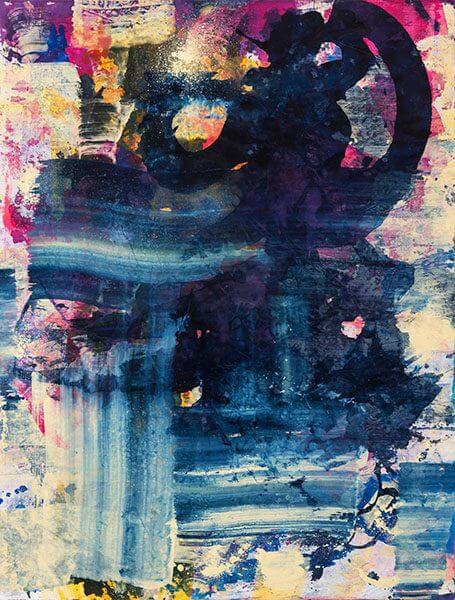
Of course, I myself am the primary source of “nature” in the work. The structure, movements, and processes of one’s body are a microcosm of those happening throughout the physical universe. Perhaps the evocation of nature that you refer to is simply a painterly embodiment of my own particular nervous system!
Nelson: How do you see your work evolving in the future?
Schlinke: By far the most important thing at this point in my development is to pare away the flotsam of values and intentions that are not truly my own. But on a more practical level, I predict a slow drift towards heavier-bodied vehicles like fluid acrylics and perhaps a more stable support. The collage work will likely emerge more. My father painted into his nineties and I have that example—if I am so fortunate! I imagine myself sitting at a table with a smallish artwork doing what Henry Miller advises: “Paint As You Like and Die Happy.”
Copyright 2018 Woven Tale Press LLC. All Rights Reserved.

